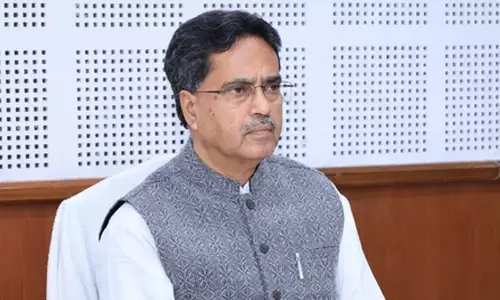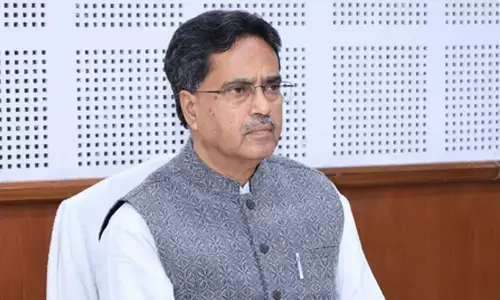Dubious claims, growing unemployment

How the economic growth of a country ought to be measured and understood, has been a matter of discussion and debate for a long time Despite all its apparent shortcomings, we, in India, have agreed to use the rate of growth of the Gross Domestic Product GDP of the country as the indicator of growth
How the economic growth of a country ought to be measured and understood, has been a matter of discussion and debate for a long time. Despite all its apparent shortcomings, we, in India, have agreed to use the rate of growth of the Gross Domestic Product (GDP) of the country as the indicator of growth.
Beginning with the Mahalanobis macro-economic model of the ‘trickle-down’ effect causing growth ‘with’ justice”, during the early years of planned economic growth in India - we changed course to an era characterised by a changed paradigm of “growth ‘and’ justice”, post the emergence of the forces of liberalisation, privatisation and globalisation in the1990s. With the reforms came the trigger for employment growth as an integral component of economic growth with India establishing itself as one of the strongest economies in the world.
The shift saw a change in emphasis, away from the somewhat romantic entanglement of the concept of growth with equity, to a new regime that allowed growth to take place freely, while parallely dealing with the problems of equity and justice that the growth process inevitable throws up. That growth is not a means to an end, but is designed to serve the people, promote development and reduce poverty is elementary knowledge.
And it is well known that growth, especially in the context of a globally integrated world economy, can no longer occur in isolation. The recent adverse impact, of the policies of the United States government in regard to outsourcing work, on the performance of the IT sector of India is a good example. Among the many other parameters that are used to measure the health of a country’s economy and its robust growth, employment has always been a major factor.
Unemployment, on account of its chronic occurrence in most countries, has become a subject of central importance in economics. In a country such as India, the manner in which employment, or the absence thereof, or even its presence in a not – completely – satisfactory form, present themselves, over different regions of the country, sections of the people and sectors of the economy, is also of considerable concern and importance.
Despite a consistent fall in the contribution of the agriculture sector to the gross domestic product, production and productivity have, in real terms, registered growth along with growth in employment.The industrial sector has shown a declining growth rate largely as a result of the uncertain economic situation prevailing internationally – with the rising oil prices contributing substantially to that phenomenon along, with falling levels in FDI, and caused also by inadequate public investment in infrastructure, despite a spurt in the transport and communication sectors.
This has, however, not impacted on the employment growth as growth in industry rarely shows corresponding growth in employment - thanks to technological innovations.The largest employment in absolute terms (over 50%) and the highest rate of growth in employment (15 to 18 %) have been recorded in the services sector, thanks largely to the explosive growth in information and communication technology.
The concomitant growth in support services on account of this phenomenon is another happy feature, especially on account of its pervasive spread practically too every nook and corner of the country. As already noted, however, the disproportionate contribution of this sector to GDP remains a matter for concern, if not alarm, on account of its fundamental feature of being not of a sustainable nature. Its intrinsic fragility is also made even more unreliable on account of stiff competition from robust rivals such as China and Japan.
Employment elasticity is a measure of the percentage change in employment associate with a one % age point change in economic growth. It indicates the ability of an economy to generate employment opportunities for this population as a percent of its growth or development process
While an employment elasticity of one denotes that employment grows at the same rate as economic growth, elastic city of zero shows no growth at all in employment, regardless of economic growth, and negative employment elasticity reflects shrinkage in total employment even while the economy grows.
This is important as it is usually believed that economic growth alone would increase employment. And, in the case of India, despite impressive economic growth, employment electricity has declined consistently.An interesting aspect of unemployment in India is that it is higher among the educated than among those who are not.
In the rural as well as urban areas it, strangely enough, is much higher among graduates and above than those with secondary education and above, generally showing signs of increase with higher levels of education! One reason, of course, could be that educated persons are unwilling to accept low – grade or informal work, even though regular jobs are not available.
Another noteworthy feature is that, probably on account of the desire for social status, the share of women in the labour force has been declining over the last 2 to 3 decades. It is also recognised as a cause for concern that the agriculture and the informal sectors contribute predominantly to total employment. In this context, signs of the structural transition from the farm to the non-farm sector need to be seen as encouraging pointers to the emergence of new avenues for employment in the country.
Advances in technology are also affecting the manufacturing and services sectors.Against the background of the growing concern about the fragility of India‘s growth rate being largely on account of its comprising substantially contributions from the territory sector, the need to step up growth in the primary and secondary sectors assumes great importance. Needless to say, this will also impart a salutary and much-needed boost to the employment situation.
Employment potential is, and will remain a function of sustainable, equitable and robust economic growth. A number of suggestions have emerged from sources such as planners, economists, academicians, political parties and civil servants about the manner in which employment growth can be achieved consistent with the imperatives of sustainable and equitable economic growth.
Doing away with unproductive subsidies and redirecting the money saved to increased investment in infrastructure development would clearly be an important step in this direction. Measures that can lead to rejuvenating the agriculture sector and giving a boost to the rural economy would also result in substantial improvement of employment opportunities.
Studies have shown, for instance, that the budgetary support made available for food and fertiliser subsidy can, if diverted, meet the entire requirement of funds for the completion of incomplete medium and major irrigation projects in the country.
Then there are many other measures of incentivising industrial activity, such as improving access to timely and adequate credit, providing incentives to new initiatives through venture capital arrangements, improving the risk-management regime through the designing of more effective insurance products and offering support to the export of goods and services.
Putting in place stronger laws and strengthening their enforcement, as also improving training facilities for new entrepreneurs, together with their workforce, are also measures that need to be tried.
It is indeed disappointing that, according to a report of the United Nations, the unemployment rate have registered an increase, albeit a marginal one, in 2017-18, the claims to the contrary of the Central government notwithstanding. Minister Santosh Gangwar’s claim of having created 17.6 lakh jobs since 2014-15, may, therefore, will have to be viewed with a certain degree of skepticism.
And this, against the much-publicised promise, in 2014, of the creation of 20 million jobs! The government of India and the State governments will perhaps do well to ponder on reasons for this distressing situation and address themselves, with a sense of purpose and urgency, to the task of devising appropriate corrective measures.
(The writer is former Chief Secretary, Government of Andhra Pradesh)
















